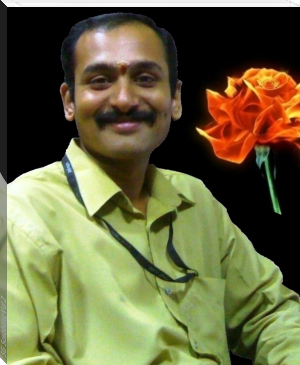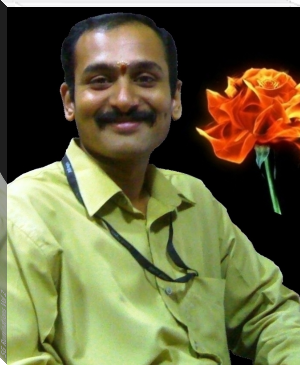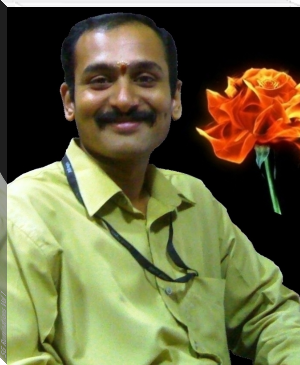SG Scribbling Vol 2, Sabari Ganesh [e reader comics .TXT] 📗

- Author: Sabari Ganesh
Book online «SG Scribbling Vol 2, Sabari Ganesh [e reader comics .TXT] 📗». Author Sabari Ganesh
Of the three psychological states of mind; Thamas is a state when the mind is idle, dormant and non-reactive. Rajas is a state of mind that is unstable, effervescent and tensed. Sathvam is the best of the three, when the mind is stable, alert, calm and active. Sathvam is the balanced state of mind that is between the two opposites - the dull mind full of inertia called Thamas; and the unstable, effervescent, rattling Rajas. Sathvam is the only psychological state of mind which upon maturity attains the ultimate - Gunaatheetham.
Every activity of man reflects either of the three states; be it food, worship, duty or love. A successful person is one who has attained the balanced state of mind called Sathvam. It is implied that, though by birth one may possess any state of psychological maturity; and the traditional customs as defined by the Veda bearing on any of the three psychological states; every effort must be focused on achieving the balanced state of mind - the stable, alert, calm and active mind termed, Sathvam.
Veda describes the presence of umpteen number of worlds; of which, it defines Earth as 'Karma Bhoomi'. When the other worlds are mere centres of exhausting the accumulated merits or demerits; the Earth alone is one such place wherein one can perform and attain the best or worst of the umpteen number of worlds; or even get liberated. It indicates the presence of activities belonging to either of the three psychological states. However, with the passage of time, when a person gets relieved of one's direct responsibilities, should attain the balanced state of mind, called Sathvam.
Veda has also categorised people based on functions as Brahmin, Kshatriya, Vysya and Sudra. The categorisation of people were based on their psychological maturity and functions performed; not birth. Ancient traditional practice aimed at a society that is distinct in functions but united in vision; similar to the senses of the body – distinct in functions but united as one body. Hence the people belonging to every category were dependent on the other aiming at mutual betterment.
Food provides the essential energy for any activity of a person in this world. The kind of food consumed determines the psychological state of a person. Veda which has categorised people based on activities has also stipulated the distinct kind of food required to promote the requisite psychological substratum. Bhaagasastra is a part of the Veda detailing the kind of food permissible to every category of people in a society that assist their moral activities aiming at the betterment of the society as a whole.
For instance, the moral responsibility of a Brahmin is to learn, recite and teach the Veda. Every activity of man is streamlined by the Veda. The moral duty of a Brahmin is to guide the society as a whole. The innate necessity for extreme patience has stipulated this category of people to remain in the Sathvik state of psychological maturity at all times. For this reason strict vegetarianism and non-spicy food is mandatory since birth for a Brahmin. Also, a life devoid of materialistic luxury so as to remain detached and selfless is stipulated.
In the case of a Kshatriya, the moral responsibility is to fight and protect the geographical territorial limits of the region. If being a King, to prune the misdeeds of the citizens in an effort to protect the innocent as guided by the Dharmasastras. These activities demand the genuine need for the psychologically effervescent and physically dominant, Rajasik state of mind. Hence spicy food and non-vegetarian diet is permitted by the Veda for those belonging to this category. However, their activities too are streamlined by the guidance of the Dharmasastras, discoursed by the Sathvik Brahmins.
The prime responsibility of a Vysya is to roam around the entire earth in pursuit of wealth and material prosperity. The objective of such a pursuit is the economic betterment of the society that one belongs to as a whole; thereby benefitting its every member. Strict vegetarianism is not stipulated obligatory by the Veda, due to the inherent practical dilemma; with consideration. Nevertheless, this relaxation is understood to be applicable only in times of critical compulsion and situational predicament.
In the case of people performing strenuous physical activities like agriculture or construction of dams and temples, the need for Thamasik state of mind is justified. Scientifically, the more strenuous and repetitive the work is physically, the more latent the mind becomes. A food regime that is much relaxed when compared to that of the Brahmins, Kshatriyas and Vysyas in terms of quality and quantity is permitted by the Veda for this category of people.
Strict vegetarianism is assigned by the Veda only for the people belonging to the category - Brahmins. A food regime that included non-vegetarian diet is permitted by the Veda for the people belonging to the other categories to promote the requisite psychological state of mind. However, the Veda has accorded a higher state of honour to the people in other categories, who followed the food regime of Brahmins and at the same time executed the moral responsibilities due to them. For instance, King Janaka of Mithila is regarded a Rajarishi.
In spite of the diet regime; since the activities were pruned by the Dharmasastras; and are performed for the betterment of the society as a whole in an interdependent manner, every category of people got elevated spiritually. Therefore, though the diet being non-vegetarian; a sensible limit on the choice of food was effortless and evident. Also, when a person from any of the other categories gets relieved off one's direct responsibilities; aimed at practising the way of life that would inculcate the Sathvik state of mind - Vegetarianism.
The life term of every person in such a societal setup was divided into four Aashramas - Brahmacharyashramam, Grihasthashramam, Vaanaprasthashramam and Sanyasashramam. Of the four; since Brahmacharyashramam is practised at the hermitage of a Guru; who is a Vedic Brahmin, strict vegetarianism becomes inevitable. In the case of a person abiding the Sanyasashramam, a vegetarian diet that includes uncooked food - fruits to a large extent becomes the natural way of life. Sanyasashramam touches the peak of vegetarianism as stipulated by the Veda.
Vaanaprasthashramam focus on Vedic activities stipulated by tradition along with spouse. However, it is devoid of sensual pleasures, aims at the purification of mind, executed at a hermitage; and so vegetarianism. Grihasthashramam is the only stage in a person's life time, when one is provided a relaxation to consume non-vegetarian diet. The justification being, the requirement of an apt psychological state of mind to execute one's moral responsibilities for the betterment of society as a whole.
Grihasthashramam is that stage of a person's life, when one heads a family. Protecting the members of one's family; shouldering the direct traditional, familial and societal responsibilities; demand a genuine need for the Rajasik or Thamasik state of mind. Hence non-vegetarianism. Even so in the case of Brahmins, the relaxation to a non-vegetarian diet is prohibited. However, practically, the inherent cruelty to a living being evident in non-vegetarian diet made it less appealing to people following the Vedic traditions.
The Veda is the source of every scripture of Sanathana Dharma. Krishna Dwaibhayana, who detailed the Veda, consequently called Ved Vyasa; summarised its essence thus -
"Slokaarthaena Pravakshyaami, Yathuktham Granthakodishu;
Paropakaara Punyaaya, Paapaaya Parapeedanam."
It infers; every scripture of Sanathana Dharma in essence dictates that one should serve others in the good of mankind to earn merits; or if to pile up sin, hurt others. Non-vegetarianism is the most prominent and subtle form of individual selfishness and cruelty to another living being. The prime objective of the Veda being streamlining the activities of every person to accumulate merits, promoted vegetarianism in principle. Yet still; relaxation to a sensible non-vegetarian diet was accorded to the specific class and period based on legitimate necessity.
In the present scenario; the distinctive nature of societal class and customs based on tradition is blurred. Segregation of a person's life time based on functions are discarded. The responsibility shouldered by a person in the present society have lost their traditional belongingness to any specific class, and period of life time. People lead a mixed up jumbled life style chosen based on convenience and sensuality. Clarity of reasoning and sensible rationalism is victimised; evidently negating the basis of adhering to non-vegetarianism.
Followers of the Veda are termed Hindu. The term "Hindu" is never available in the traditional scriptures. Hindu is a term accorded to the followers of the Veda by the rest. However, subsequently a shrewd definition was accorded to the term, "Hindu" -
"Himsaayaam Thooyathey; Yah Sah Hindu Ithyapidheeyathey!"
It describes Hindu as the one, who empathises with the suffering of another living being. In spite of the inherent ingenuity; this description clearly evidence the prevalence of vegetarianism among the followers of the Veda in India. It is thus our responsibility to adhere to strict vegetarianism in a scenario that lacks substantial ground justifying non-vegetarian diet; else the resultant shall be the loss of a unique and profound ideal to the entire world.
ImprintText: Sabari Ganesh
Images: Sabari Ganesh
Cover: Sabari Ganesh
Editing: Sabari Ganesh
Translation: Sabari Ganesh
Layout: Sabari Ganesh
Publication Date: 11-26-2019
All Rights Reserved





Comments (0)